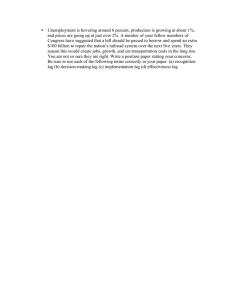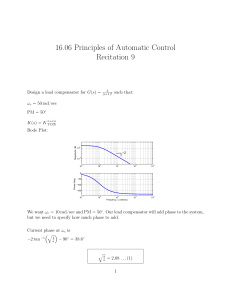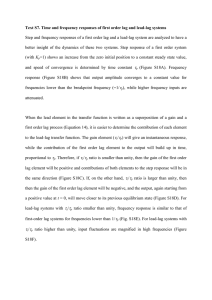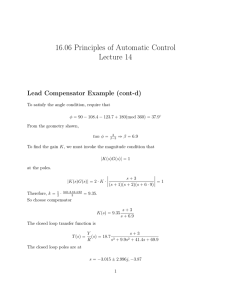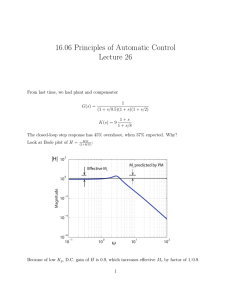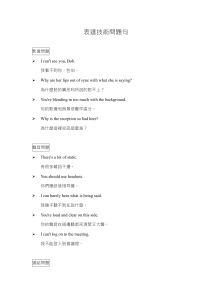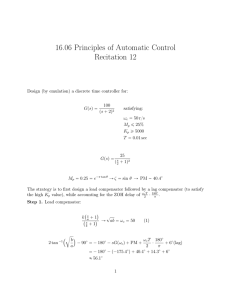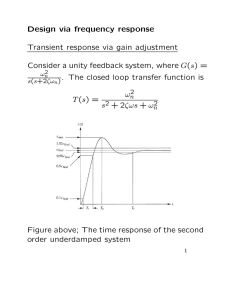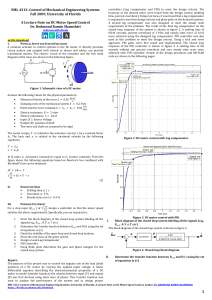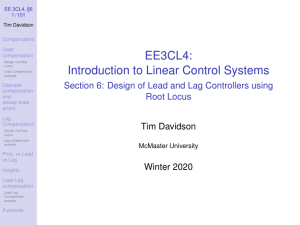Handout 7
advertisement
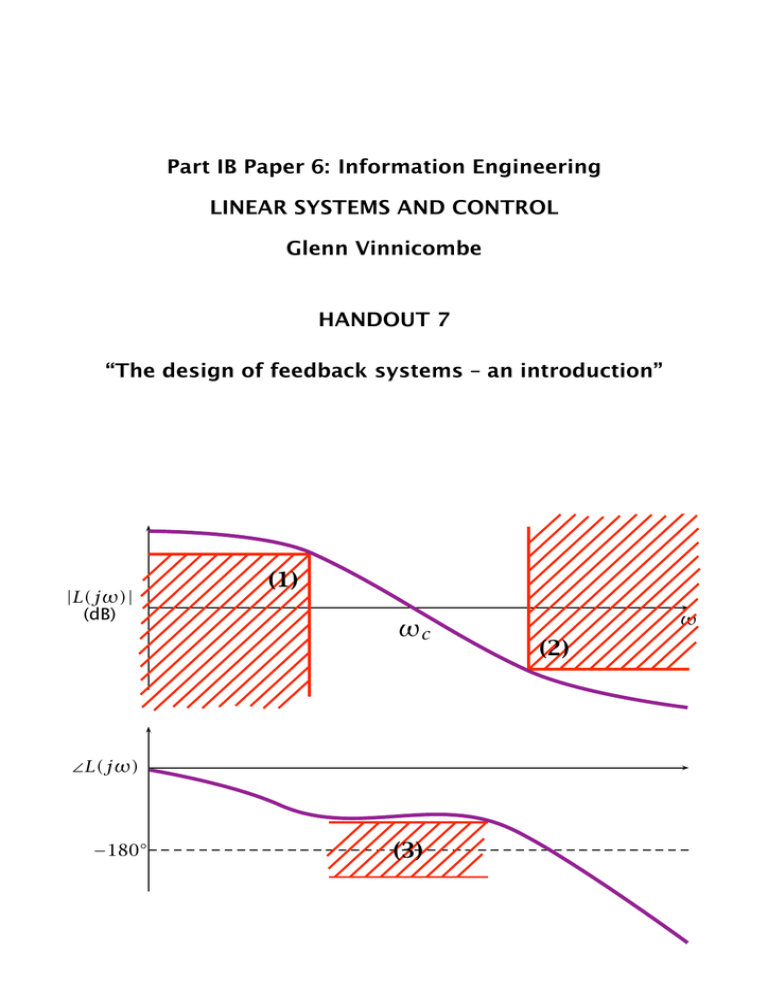
Part IB Paper 6: Information Engineering LINEAR SYSTEMS AND CONTROL Glenn Vinnicombe HANDOUT 7 “The design of feedback systems – an introduction” |L(jω)| (dB) (1) ωc ∠L(jω) −180◦ (3) ω (2) 7.1 Feedback system design, a loop-shaping approach • This consists of choosing K(s) to shape L(s) = K(s)G(s) such that 1. |K(jω)G(jω)| ! 1 for frequency ranges where the benefits of feedback are sought (typically ω < ωc ) ! ! (in order to ensure that the sensitivity function !S(jω)! " 1 at those frequencies.) 2. |K(jω)G(jω)| " 1 at other frequencies (typically high frequencies ω ! ωc ) (ensuring that the complementary sensitivity function ! ! !T (jω)! " 1 at those frequencies.) 3. K(jω)G(jω) satisfies the Nyquist stability criterion, with adequate gain and phase margins. (ensuring that neither S(jω) or T (jω) have a large peak in the crossover region in between) 1 Recall that S(s) = 1+L(s) = Td!→y and Tr !→e L(s) = −Tn!→y and Tr !→y and T (s) = 1+L(s) d̄(s) r̄ (s) + ē(s) Σ K(s) G(s) + + Σ ȳ(s) − n̄(s) Σ To achieve this, we can use combinations of phase lag and phase lead compensators. Phase lag compensators are a generalized form of P+I action and phase lead compensators are a generalized form of P+D action. Note: Example 2 of Handout 4 is a phase lead compensator and Example 3 is a PI controller (and so a special case of a phase lag compensator). • K(s) = k s +α for β < α (< ωc typically) s+β = kα 1 + s/α β 1 + s/β – Phase lag compensator (a generalized form of proportional+integral action, this becomes a PI controller for β = 0). kα/β 20 0 e.g. k = 1 α = 0.3 β = 0.03 α β Gain (dB) Good! !20 !40 !2 10 !1 10 0 10 1 10 Phase (Degrees) 90 Bad! 0 !90 !2 10 !1 10 0 10 ok if ωc ! Frequency (rad/s) 1 10 here – improves low frequency gain (and so reduces steady-state errors) at the expense of introducing phase lag at frequencies between ω ≈ β and ω ≈ α (although this is not an issue if α " ωc ) . • K(s) = k s +α for α < β (and α < ωc < β typically) s+β – Phase lead Compensator (a generalized form of proportional+derivative action). √ 20 kα/β Bad! 0 α Gain (dB) e.g. k = 10 α = 0.2 β=2 β Bad! !20 !40 !2 10 !1 0 10 1 10 10 Phase (Degrees) 90 0 α β Good! !90 !2 10 !1 0 1 as long as ωc ≈ here 10 10 10 Frequency (rad/s) – can improve gain and phase margins (improving robustness and damping) at the expense of decreasing the low frequency gain (increasing steady-state errors) and increasing the high frequency gain (increasing sensitivity to noise). Note: We can use a combination of Phase Lead and Phase Lag. Lead/lag controller design for the Lego “Hubble” 0+1)*,2/ $" " !$" !! !" " !" ! %&'()*&+,-./ !" # !" 67+.' 5" " !5" !!4" !#3" !! !" G(s) = " !" ! %&'()*&+,-./ !" # !" 5.431 s2 s ( +2×0.1613 10.745 +1)(s/16.54+1) 10.7452 Lead/lag controller design for the Lego “Hubble” 0+1)*,2/ $" " !$" !! !" " !" ! %&'()*&+,-./ !" # !" 67+.' 5" " !5" !!4" !#3" !! !" " !" ! %&'()*&+,-./ !" # !" ( L(s) is plotted in each case) What the course was about: The keys to understanding the course are the following two relationships: The relationship between the time and frequency (Laplace) domains: Steady state responses (to both constant and sinusoidal inputs). Pole locations. The relationship between open and closed loop properties (i.e. predicting properties of the feedback system from its return ratio). Nyquist stability criterion (predicting stability of the feedback system). Gain and phase margins (predicting the robustness of that stability and, indirectly, closed loop pole locations). Understanding the map L(jω) !→ L(jω)/(1 + L(jω)) and L(jω)/(1 + L(jω)) (predicting the performance of the feedback system – which involves reading off L(jω) and 1 + L(jω) from the Nyquist diagram). That is, it is all about understanding the relationship between various diagrams – if you can understand the relationship between all the figures in the vcl demo (which you can download from www-control.eng.cam.ac.uk/gv/p6) then you’ve got it!
